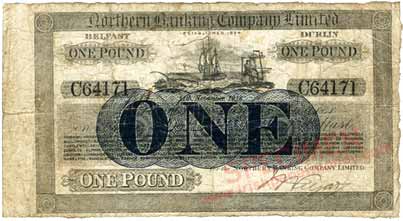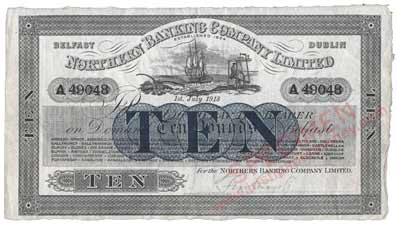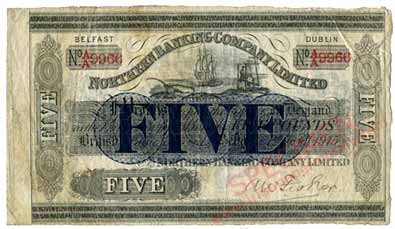
Issued notes of Type A are very rare, as are examples of Type B prior to ca1900. Proofs and specimens of earlier issues are available to collectors.
All branches of the bank listed on each banknote. Banknotes printed on both sides. Head Office Belfast.
Five Types by design variation
There are five Types by major design variation for Series B banknotes, as listed below.
Bank branches listed in the borders of each banknote on £1 notes, and on the top and bottom borders of higher denominations. 13 Branches appear on a Proof £20 dated 1857. The number of branches increases with time.
Extra branches were added at various locations on some banknotes as follows:
a. ca1873 BALBRIGGAN, DUNGARVAN, HILLSBOROUGH, OLDCASTLE, STROKESTOWN, BALLINAMORE, CUSHENDALL, FIVEMILETOWN.
b. ca1875 BALBRIGGAN, DUNGARVAN, HILLSBOROUGH, OLDCASTLE, STROKESTOWN, BALLINAMORE, CUSHENDALL, FIVEMILETOWN, BALLINGARRY, IRVINSTOWN.
Type A1. Multi-branch note with Ent’d bottom left (ca.1851-1856)
Type A2. Similar to A2 but with check numbers (ca.1859-1863)
Type A3. Ent’d now omitted but check numbers present (ca.1864-1866)
Type A4. Similar to A3 with check numbers discontinued (ca. 1866-1868)
Type A5. Similar to A4 but denomination in value panel lower left in white rather than shaded (1868-ca1883).
Denominations recorded: £1.
Denominations recorded: £1, £5, £10, £20.
Type D. 1907. Reverse side printing introduced
Denominations recorded: £1, £5, £10, £20.
Extra branches were added at various locations on some banknotes. The combinations listed have been observed so far. Certain combinations occur on specific denominations.
Type D1. Red serial numbers.
£1 notes up to 1916, single letter prefix. £5 notes, single letter prefix. £10 notes, no prefix.
Type D1b. £5 notes 1915, letter over letter prefix. Red serial numbers.
Type D2. Black serial numbers.
£1 notes from 1916, single letter prefix. £5 notes 1915, letter over letter prefix. £10 notes 1917, single letter prefix. £20, no prefix.
Extra branches are integrated into the main blocks on the banknote borders on some denominations of Types A to D. This gives an indication of when some of the denominations were printed.
1. ca.1873 BALBRIGGAN, DUNGARVIN, HILLSBOROUGH, OLDCASTLE, STROKESTOWN, BALLINAMORE, CUSHENDALL, FIVEMILETOWN
2. ca.1900 BRAY, DUNGLOE
3. ca.1905 DRUMSHAMBO, HOLLYWOOD
4. ca.1908 ELPHIN (BERAGH stamped on by hand)
5. ca.1912 BERAGH
6. ca.1914 KELLS
7. ca.1913 BERAGH, KELLS
8. ca.1913 KINGSCOURT, BERAGH, SHERCOCK, KELLS
9. ca.1916 KINGSCOURT, BERAGH, SHERCOCK, KELLS, ARMOY, NEWCASTLE
10. ca.1916 ARMOY, NEWCASTLE
11. ca.1918 KINGSCOURT, BERAGH, SHERCOCK, KELLS, ARMOY, NEWCASTLE, BOYLE, OMAGH, DUNGANNON, PORTAFERRY, AUGHNACLOY, BALLYMONEY, MILFORD
12. ca.1919 KELLS, ARMOY, NEWCASTLE, BOYLE, OMAGH, DUNGANNON, PORTAFERRY, AUGHNACLOY, BALLYMONEY, MILFORD, CARRICKMACROSS, MAGHERA, PORTADOWN.
Type E. 1918. Branches listed in the centre of each banknote in several lines
on £1, £5, £10, £20 notes.
The design of all denominations produced by the Northern Bank was modernised to make room for a greater number of branches by listing them in several lines in the centre of each note rather than along the borders.
Type A
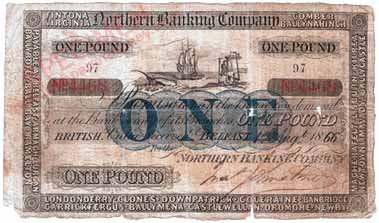
Type B

Type C
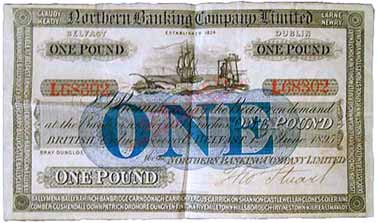
Type D

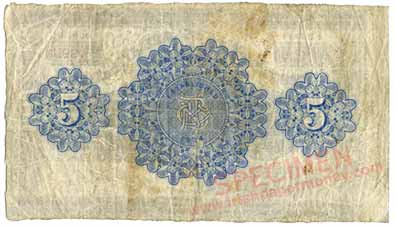
Type E
